Traditionally, Wi-Fi has been used as a best effort connection to the internet, for checking email or surfing the web. Today, Wi-Fi is playing an increasingly central role in home networking—one that we rely on every day for communication, entertainment, home automation and more.
Now, Wi-Fi networks must deliver multiple HD video streams (including OTT video) and other high bandwidth content to devices like HDTVs, laptops, tablets and smart phones. In addition, as customers have come to depend on Wi-Fi, they have also come to expect a great Wi-Fi service experience regardless of what device they use or where they are. However, Wi-Fi technology has limitations and weaknesses due to the fact that it operates in shared, unlicensed spectrum.
Let’s take a look at some of the challenges service providers and their technicians face as they strive to deliver a great Wi-Fi experience to customers. After we explore these challenges, we’ll take a look at best practices for technicians installing and troubleshooting Wi-Fi.
Wi-Fi Challenges
- New services in the Home: Customer are now using new devices such as multi-room DVRs, Next Gen Media Servers, Wireless STBs and IP clients, creating a need to deliver multiple simultaneous HD video streams wirelessly. A variety of Over-the-Top (OTT) applications from providers such as Netflix, Google, Apple are also being used extensively that require seamless Wi-Fi for optimal performance.
- Customer education and expectations: Customers frequently have unrealistic expectations about wireless capabilities.
- Visibility into customer’s network: With the rise of the connected home and the Internet of Things, the performance of the home network is more important than ever. However, current testing and monitoring systems provide limited visibility of home network performance.
- Ownership of the customer’s entire experience: Up until the last year or two, a carrier could simply tell the customer that wireless is their responsibility. This is no longer the case and the provider needs to establish a testing methodology that enables them to truly own the customer’s experience.
- Tools and Technician Training: Wi-Fi is more complex than traditional cable technologies leading many providers to assume it’s beyond the abilities of their technicians. Providers need tools that make it easy for any technician to rapidly become effective at installing or troubleshooting Wi-Fi home networks.
Wi-Fi Best Practices
It should be understood that there is no single test measurement that provides a complete picture of Wi-Fi performance. Measurements like RSSI/Received Power and Signal to Noise Ratio (SNR) help us to understand the basics, but do not present a complete picture.
Recommended Installation Practice
- Perform a basic site survey
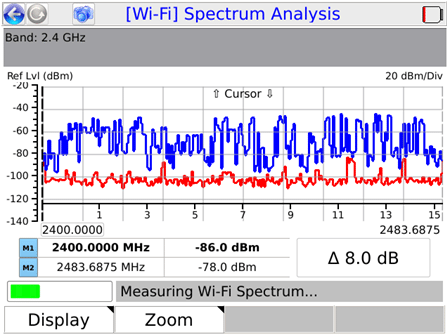 This does not need to be a complex test or take more than a few minutes. This should also not force a technician to deploy numerous devices or set up complex maps. The goal of a practical site survey is to quickly identify the best location for the router as well as to identify possible interference or other Wi-Fi signals.
This does not need to be a complex test or take more than a few minutes. This should also not force a technician to deploy numerous devices or set up complex maps. The goal of a practical site survey is to quickly identify the best location for the router as well as to identify possible interference or other Wi-Fi signals.
A basic spectrum analyzer that evaluates the Wi-Fi spectrum is recommended. In the diagram on the right, it is fairly easy to see that the RF spectrum is not very noisy, but that there is clearly usage on channels 1 and 11 of the 2.4GHz spectrum. This test can be run in continuous mode as the technician moves around the customer’s house.
- Install and validate service at the router or access point
Once you have identified the best location and installed the router, it is recommended that you validate the service via Ethernet. The most common method today is via speed tests, but keep in mind that you need to consider a strong strategy for supporting 1 Gbps service. Many companies are migrating to a Layer 4 (TCP/UDP) based tests to better understand the customer’s true experience. If your test results are slower than expected, then you need to check potential problems like latency or dropped packets.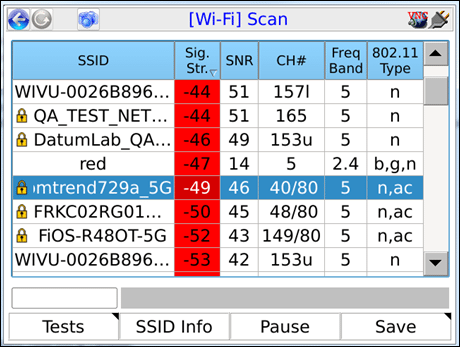
- Validate the RF interface
Once you have verified a clean service to the router, it is time to start testing the actual RF interface of Wi-Fi. Again, this should not be a long list of tests, menus or charts. The first three recommended tests for almost any network are explained below, but keep in mind that this only part of the story, and networks can still have problems even if these three tests are successful. It is recommended that you first perform these tests while close to your router and then roam around the house to validate each location.
- PHY rate: This measurement is one of several measurements that indicate how well or poorly Wi-Fi signals are traveling through the home from the point of origin to the point of reception. As you can see on the right, the highest PHY rate possible for this specific network is 1300 Mbps, but the actual rate is 117 Mbps.
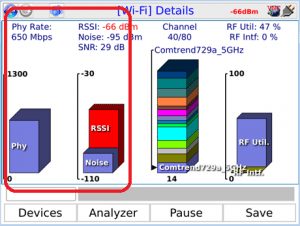
- RSSI (dBM): Received Signal Strength Indicator (RSSI) is a measurement of how well your device can hear a signal from an access point/router. This is a measured parameter based on the beacon and data frames coming from AP.
- SNR: Signal to Noise Ratio is a comparison between the RSSI and noise for all interference sources. The higher the SNR, the better the separation between RSSI and noise and the better quality the end-user will experience.
As mentioned previously, these measurements only tell part of the story. They will definitely affect the service if they are bad, but if we dig just a bit deeper into the results you can much more accurately predict how the Wi-Fi network will perform.
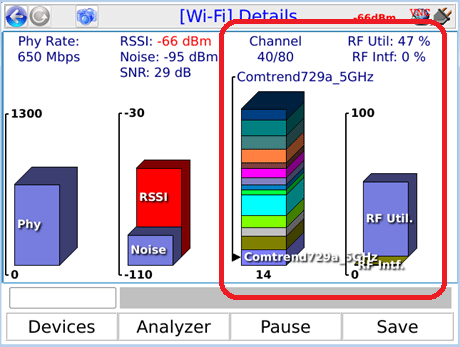 Channel usage: You should always seek out channels with the least amount of traffic. You cannot simply trust the auto settings on a router so validate that you have selected the channel with least amount of usage.
Channel usage: You should always seek out channels with the least amount of traffic. You cannot simply trust the auto settings on a router so validate that you have selected the channel with least amount of usage.- RF utilization: This shows how occupied the channel you are connected to is. The higher the number, the more limited resources and capacity are, so you want low utilization whenever possible.
- RF interference: This shows any signals in the same RF band that are not Wi-Fi related. As with utilization, you want this to be as low as possible.
Once you have validated these parameters throughout the home, you begin to have a good understanding of how the RF interface looks. This is very similar to how we qualify a cable prior to connecting a device but through wireless parameters.
 Once this is complete, you can then go one step further by looking beyond your channel. Other channels can actually cause problems even if they are not on the same channel.
Once this is complete, you can then go one step further by looking beyond your channel. Other channels can actually cause problems even if they are not on the same channel.
- Co-channel interference relates to another network that is sharing the same channel as you. If this is just one or two, it will not necessarily cause problems but too many can increase RF utilization.
- Adjacent channel interference is interference from a channel next to or adjacent to you.
- Non-802.11 interference are signals that can come from other devices like microwaves, Bluetooth devices, baby monitors and even electrical devices.
- Test network with customer devices
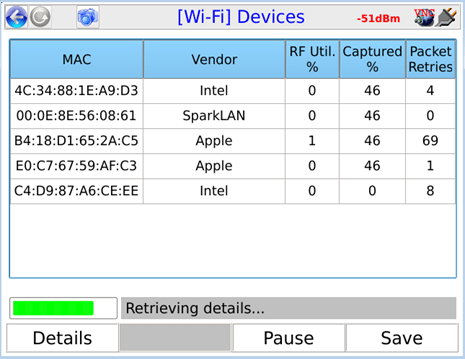
This is an easy test to run but not normally considered until there are issues. Simply put, some devices have the ability to use a lot of the available bandwidth. This is more prevalent in the 2.4GHz range but still important to test. Have the customer connect their devices and monitor the usage. Some devices like gaming systems or video have the ability to utilize more of the network than others. If you look at the chart on the right, the Intel device is using 67% of the RF bandwidth. You will also notice that several devices are actually struggling with throughput and having to retransmit packets.
- Test the service
Last, but definitely not least is to verify all services and devices that are connected to the wireless network. This can include web pages, speed tests or downloading videos. Keep in mind that your wireless network is simply not capable of running the same speeds as your wired network.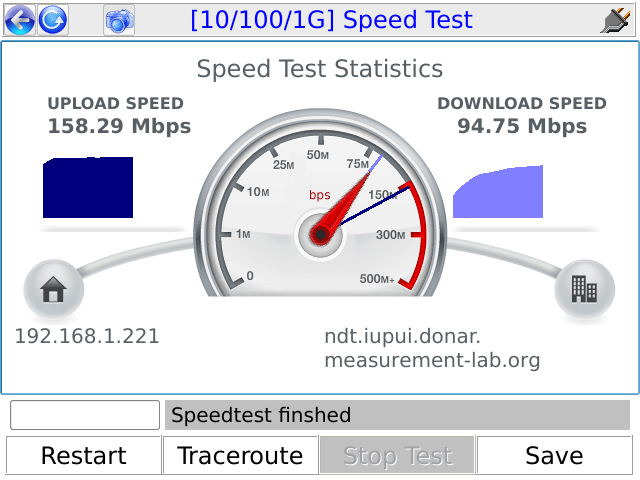
- Educate the customer
This is probably the most important part of your job when installing and testing Wi-Fi. Many customer complaints can be prevented if they just understand the basics.
- Areas where signal is weak or affected by another network
- Areas where signal is very strong and the service should perform well
- Difference between 2.4GHz and 5GHz networks
- Wi-Fi speeds will not match a cabled (Ethernet) connection
- Impact of certain devices like gaming systems
- Impact of specific applications that could potentially use a lot of bandwidth (i.e. video)
- The more devices the customer connects via Wi-Fi, the less bandwidth there is available
Summary
Wi-Fi networks are a now a reflection of the provider. If a technician is equipped with the right tools and a basic understanding of the technology, then many problems and complaints can be prevented fairly easily. The testing strategy does not have to be complicated and basic tools are available for a reasonable price, but a process and pass/fail thresholds should be established.
About the Author
Robert (Rob) Burke is a Sales Director with Spirent Communications with over 29 years of experience in the telecommunications industry. Much of this time has been spent working specifically for test and measurement companies. Prior to working for Spirent, he held numerous roles as a technical trainer, consultant and technician that specialized on in-home and outside plant testing concepts. Rob’s extensive field experience provides the foundation for his practical knowledge and hands-on applications in both wired and wireless communication systems.
Spirent Communications enables innovations in communications technologies that connect the smarter world. Whether it is service provider networks, data centers, enterprise IT, mobile communications, connected vehicles or the Internet of Things, Spirent solutions are working behind the scenes to help the world communicate and collaborate faster, better and more securely.